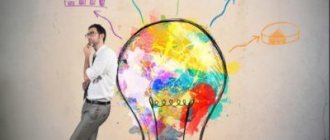In philosophical treatises and special textbooks on psychology, there is a special classification of thinking according to types, types and forms, but how can an average person interested in this topic figure it out?
Such literature provides detailed tables, diagrams and drawings that explain why these particular types of thinking are distinguished or by what criteria the main types of thinking are determined. Today we will try to understand what is meant by the classification of types and types of thinking in psychology.
Thinking is the highest process of information processing in the human brain. It is based on the main criteria:
- Concept.
- Judgment.
- Conclusion.
Thinking what it is
Thinking is the highest level of human consciousness, allowing a person to navigate the world around him, accumulate experience, and form an idea of objects and phenomena. It is an internal system capable of modeling the patterns of the world around a person, predicting possible developments of events, analyzing what is happening and accumulating unique truths.
Main functions: setting a goal and planning its achievement, finding a way out of various situations, monitoring what is happening and assessing the degree of achievement of set goals based on personal motivation. In psychology, there are different types of thinking, both healthy and pathological.
Types
Types of thinking reflect a person’s perception of the world around them. Scientists identify 5 separate types. Most agree that they all tend to combine. There are the following concepts about the type of thinking:
- Idealistic.
- Irrational.
- Rational.
- Analytical.
- Synthesizing.
Most often, idealistic and irrational, analytical and synthesizing types are combined, but more bizarre forms are also found: rational with synthesizing, for example.
Forms
In psychology, the main forms of thinking are distinguished, including concept, judgment and inference:
- The concept forms a person’s idea of surrounding phenomena and objects; this form is inherent only in verbal speech and allows one to combine objects and phenomena according to some characteristics. Concepts are divided into concrete (true meanings of an object or phenomenon “house”, “child”) and relative (depending on the perception of different people, for example, what good and evil are). The content of existing concepts is revealed in speech through judgments.
- Judgment - refers to a form that represents a denial or statement about the world around us or a certain object. The formation of judgments is possible in two ways: the perception of concepts that are closely interrelated or obtained in the form of an inference.
- Inference represents the formation of a new judgment based on two or more existing ones initially. Any conclusion is formed as a chain of well-founded ideas. The ability to make inferences depends on the stage of development of thinking; the higher it is, the easier it is for a person to find a solution to a certain problem.
All inferences are divided into inductive and deductive. In the first case, the judgment moves from a single concept to a general one, and deductive, on the basis of existing general ones, a whole group of phenomena or judgments is generalized into one general one.
Methods of thinking involve different levels, where at each stage certain goals are achieved: collection of information, analysis of available data and inference as a guide to action or inaction.
Research methods
To obtain the information of interest, psychologists use several practical techniques:
- Observation - Using this technique, you can obtain data about a person's behavioral reactions. By applying the practice of self-observation, one can obtain information about how judgments are made.
- Conversations are used to obtain data about the subject’s attitude towards solving various problems.
- Testing is a technique used to determine the level of intelligence.
- Experiment - certain conditions are created around the subject in order to reproduce mental activity under the influence of surrounding factors and various stimuli.
Processes
The thinking process is a purposeful process of operating with concepts and judgments to obtain a result. The process is preceded by a certain situation (which by default will be the condition of the task), followed by the collection of information and its analysis.
At the end of the chain, a person comes to a conclusion, which involves solving a given problem and finding a way out of the current situation or predicting various options for the development of events.
There are only 4 stages of the process aimed at finding a solution:
- Preparation;
- finding a solution;
- inspiration to achieve it;
- checking the results.
The whole process consists of a chain of points flowing from each other.
The process begins with motivation, characterized by the desire to find a solution. This is followed by the collection of information (initial data), their evaluation and conclusion.
Thinking techniques:
- analysis is a mental “sorting out”. Analysis represents the decomposition of a problem into its components and the isolation of its fundamentals;
- synthesis is the process of combining parts into a single whole according to certain characteristics. The relationship of each component to the whole is mentally established. Synthesis is the opposite of analysis and is represented by the generalization of existing details into a single whole;
- comparison is the process of identifying the similarities between objects and phenomena and their differences;
- classification represents a breakdown point by point, forming certain classes and subclasses;
- generalization is the identification of what is common among various objects or phenomena and the identification of what is identified into one group. A generalization can be simple (based on one sign or property) or complex based on different components;
- specification allows you to determine the essence of a phenomenon or object;
- abstraction is the opposite of concretization, when an abstract image is created during the process. The development of abstract perception is influenced by exercises that require a creative approach.
Methods for developing thinking are known to psychologists, neurologists and teachers. Techniques include problem solving, games, learning to look from different angles, training imaginative and intuitive thinking through creativity. In development, it is important to take into account individual characteristics of thinking.
A person with a pronounced tendency towards fantasy should pay more attention to the development of a creative and extraordinary approach in the process of processing information. On the contrary, if you have accuracy and consistency, you should pay more attention in this direction.
Characteristic signs
Thinking has a number of characteristic features:
- By its nature it is a social phenomenon. This is due to the fact that to solve a problem people use different rules, concepts, laws that were formed as a result of the development of mankind.
- Thought processes are associated with language knowledge. With the help of language you can express thoughts. Using language skills you can explore the objective world.
- Thought processes are determined by the emotional and volitional aspects of the personality.
Disorders
Thought disorders are disorders of mental activity. Violation is divided into quantitative and qualitative.
Quantitative forms of the disorder are characterized by speech impairment, delayed neuropsychological development, or mental retardation.
Forms of quantitative disorder:
- Mental retardation (MDD) is diagnosed in children 2-3 years old. Treatment is prescribed by a neurologist.
- Oligophrenia (mental retardation is characterized by impaired development of a child from an early age). A child with oligophrenia is observed by a neurologist and psychotherapist. The goal of treatment will be socialization and learning self-care.
- Dementia is a disorder of mental processes that manifests itself in adulthood or adolescence. Observation by a psychotherapist.
The speed of thinking depends on the predominance of processes in the cerebral cortex. This may be excessive excitement or, on the contrary, inhibition of mental activity:
- Disruption is characterized by a rapid change of thought, in which speech becomes absurd, logic and consistency of judgments are completely absent. Speech consists of fragments of phrases quickly replacing each other. The grammar of speech is usually preserved. This disorder is inherent in schizophrenia.
- Manic syndrome is characterized by accelerated speech and a simultaneous increase in psycho-emotional background. Speech is accelerated, the patient can speak “excitedly”, especially pronounced in certain topics.
- Slowing down of mental processes is inherent in depressive syndrome. Distinctive features: absence of thoughts in the head, slow speech taking into account the slightest details that are not related to the essence of the issue, predominance of a depressed mood.
- Thoroughness is expressed in excessive “drowning” in details. The patient has difficulty switching from one question to another, and rigidity of thinking is observed. Circumstances are inherent in diseases of the nervous system (Epilepsy).
- Reasoning is revealed during long-term communication and is expressed by a tendency to teach. When a person does not answer the question posed, but talks about things that have nothing to do with him and strives to teach life to everyone with whom he begins to communicate.
- Autism develops in withdrawn people. A distinctive feature of this disorder will be isolation from the world, poor orientation in society and immersion in internal experiences, which often do not correspond to the real state of affairs.
- Obsessive syndrome is characterized by obsession with ideas or thoughts that the patient cannot get rid of, although he understands the absurdity. Obsessive thoughts depress a person, cause negative emotions, make them suffer, but the patient cannot cope with them. They arise against the background of persistent excitation of a part of the nervous system.
- Phobias (unreasonable fear) . Various phobias arise against the background of overexertion and performing a difficult task for an adult or child. In childhood, fear of punishment gives rise to various phobias.
- Extremely valuable ideas arise in adolescence. The predominance of a brightly colored emotional background indicates the development of this syndrome. This disturbance of consciousness does not cause suffering to the patient.
- Delusional thinking (often accompanied by hallucinosis) is characterized by the emergence of persistent thoughts of ideas that cannot be convinced. Inference is based on a logical conclusion made on the basis of some data. This could be fear of persecution, unreasonable jealousy, self-flagellation. Delusional thinking can be dangerous for others and the patient with a pronounced syndrome. Treatment by a psychotherapist or psychiatrist is required.
Online program "Cognitive Science"
Within two months, with the help of special brain training, you will learn to apply more than 20 thinking techniques in your life. This will allow you to think logically and consistently, quickly make effective decisions and find innovative approaches to difficult problems. The lessons not only train general memory and logic skills, but also provide specific models and algorithms of thinking. While participating in the program, you will learn to apply your knowledge and skills in practice, receive examples, case studies, special games and exercises, and short lessons of 15-20 minutes will help you develop your thinking without distraction from your main activity and show results in the first week . Find out more...
We hope that now you will have more faith in your own strengths and confidence that getting rid of templates and ossified thinking is very simple. Good luck!
We also recommend reading:
- Storytelling
- How to develop a child's thinking
- 5 Ways of Thinking
- Harmful Thinking Styles
- Interesting things about cognitive distortions
- The best blog materials in 2021: thinking development, brain training, self-education
- Digest: critical thinking
- Intelligence and its development: several recommendations
- Types of thinking
- Fixed Mindset
- Two Ways of Thinking by Carol Dweck
Key words:1Cognitive science
Development (exercises for training)
The development of thinking begins at an early age. At birth, the baby does not have the ability to think, but by the age of one year the beginning of thought processes is formed. To develop thinking, knowledge, experience, and memory are necessary. In the process of development, the child accumulates the necessary components through knowledge of the world around him and the simplest thinking begins to manifest itself.
The speed and quality of the formation of thought processes depends on how much attention parents pay to this issue. It is necessary to constantly work with the child to quickly develop and consolidate thinking skills.
The ability to form thoughts encourages self-learning and knowledge. The development of thinking occurs continuously from birth until complete extinction in the process of communication. Activities and learning new things in everyday life are shaped by a person’s subconscious. At each life stage it has its own characteristics:
- For young children, thinking is visual and effective. All processes aimed at performing the simplest tasks (taking a toy, opening a box, bringing something or getting something). The child thinks, acts, develops. This continuous process is learned in everyday life both through play and through the need to achieve certain actions.
- When mastering speech, the child learns to generalize and gradually his thought process goes beyond the visual and effective. Thinking and speech are in close connection; human speech contributes to the development of abstract thinking, the ability to generalize objects and phenomena, and to identify the essence based on acquired knowledge. Speech in adults is the main way of transferring experience and skills, which greatly facilitates learning.
- The expansion of speech allows one to express oneself in words; the child moves more towards figurative and abstract thinking. At this stage, fantasy is formed. Creative abilities develop.
- Schoolchildren learn to operate with knowledge acquired verbally (general education subjects). There is no practical confirmation by experience. This stage teaches you to draw conclusions based on logical connections and accumulated knowledge about objects and phenomena. Various school curriculum methods increase the efficiency and speed of operating with concepts and reaching conclusions in a short time in the presence of insufficient knowledge about a subject or phenomenon.
- Higher grades promote the formation of abstract thinking. Studying and analyzing fiction provokes the development of thinking and imagination.
The older the child gets, the more thinking methods are involved in the daily process. The main means of developing children's thinking is education, including the formation of speech, the study of objects and phenomena through verbal transmission of data and the formation of abstract thinking and imagination based on fiction, creativity (drawing, knitting, embroidery, wood carving).
The stages of development of thinking directly depend on what was learned earlier and the level of intelligence. Usually appropriate for age categories.
In the accumulation of a conceptual base, several levels are distinguished: the higher the level of development, the easier it is for a person to generalize or analyze phenomena (or objects), the easier it is to find a solution to the question:
- The first level is characterized by the ability to generalize simple concepts accumulated by personal experience or learned when presented in verbal form.
- The second phase is marked by the expansion of conceptual thinking.
- The third level is characterized by the ability to give clearer concepts of conditions, identify specific signs and support what has been said with specific examples from life that are suitable for the meaning and conditions of the task.
- The fourth level is the highest level of conceptual thinking, in which the individual has complete knowledge about an object or phenomenon and easily determines its position in the world around him, indicating the relationships and differences.
Important! The higher the level of knowledge of concepts, the clearer the judgment becomes and the easier the conclusion is reached.
Historical sketch
For the first time, questions about the study of thinking arose in ancient times. Scientists and philosophers of that time studied thought processes from the point of view of logic and philosophy. The most outstanding researchers of the ancient era who made a great contribution to the study were: Alcmaeon of Croton, Pythagoras, Hippocrates, Aristotle, Epicurus, Protagoras.
There were no significant discoveries during the Middle Ages. Active study began only in the 17th century. At the same time, thinking was considered an innate ability, which was considered individually, without the influence of the psyche. A teaching that has significantly influenced the study of thought processes is pragmatism. It appeared at the end of the 19th century. In the 20th century, followers of the Würzburg school began to engage in in-depth research. The practical experiments of this school were aimed at dividing thinking into separate stages.
Gestalt psychology studied productive thinking. At the same time, followers of behaviorism were engaged in research. They studied the skills that people used to solve various problems.











